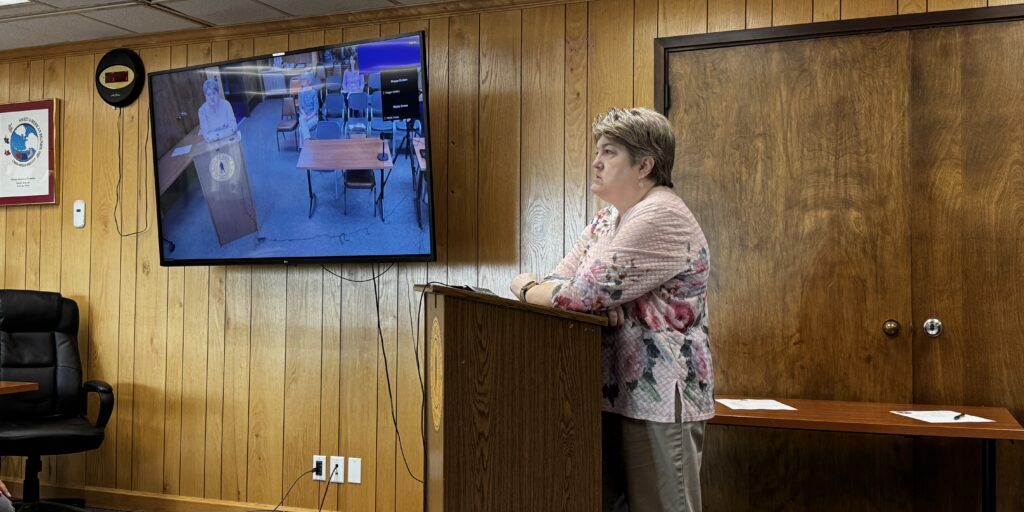Norton Sound storms have caused large chunks of the Shaktoolik berm to erode this year, necessitating emergency repairs. As such, the community recently received $1 million from the National Coastal Resilience Fund to help them maintain the berm.
KNOM’s Emily Hofstaedter reports on how the berm is protecting the community’s most vulnerable areas from the ocean waves, for now.
The Shaktoolik IRA Office is a cozy retreat from the single degree weather where ice fog clings to everything outside. Community Coordinator Sophia Katchatag sits at her desk and lays out the plan to spend a $1 million grant Shaktoolik received from the National Coastal Resilience Fund. That fund is a private-public partnership between the National Oceanic and Atmospheric Association, Shell, and TransRe.
“Half of that [funding] will be used for equipment, the other half of that will be used for labor. We purchased two dump-trucks, very old models, a few years back and I think the trucks did [their] last year this year (in 2019) so we’re expecting new equipment in the spring.”
– Sophia Katchatag
Shaktoolik is on a gravel sand-spit between the Tagoomenik River and Norton Sound. While the berm is all that stands between the village of about 250 people and the salt-water waves, there are some areas that need more protection from erosion than others.

Katchatag is especially concerned about the front of the two tank farms and the back of the school.
“We have an evacuation place and that is the school.”
Shaktoolik’s school is on the ocean side of the community, behind the berm.
Findings from the Shaktoolik Inter-Agency Planning Work Group state that even though the community’s school was reinforced and expanded to become a storm shelter, it still isn’t elevated high enough. Nor is it large enough to hold all of the residents in the event of severe flooding or another type of large-scale weather event.

During bad storms, Katchatag says a group of volunteer storm watchers will chart the water levels, sometimes taking flashlights into the night.
“We had some storm watchers making sure that the ocean isn’t going over the berm or that the river wasn’t rising over and if that were to be they would alert the community to go to the school ASAP.”
That hasn’t needed to happen yet.
Erosion also causes concern beyond that of life and property, it’s a public health issue too. Katchatag explains that Shaktoolik uses their river as the only fresh-water source, but if salt water mixes with it, then they can’t rely on the river. She’s working on securing more funding to reinforce that part of the berm before erosion turns them into an island.
City Clerk Isabelle Jackson says the water plant does keep a reserve of up to three months water for emergencies and would issue a boil-water notice if needed. But they wouldn’t be able to desalinate the water if the barrier between ocean and river were permanently eroded.

Some Shaktoolik residents aren’t sure if the berm, even a reinforced berm, can hold up against the increasingly strong and unpredictable coastal storms.
Shaktoolik Mayor Edgar Jackson, Sr. and his wife, Helen, remember autumn storms from their youth, in the fifties and sixties, which were big, but Edgar says patterns and intensity are definitely changing.
“You don’t know when it’s coming, without expecting them they come, come and go! But so far, we’ve been lucky!
-Helen Jackson

One of those unpredictable storms came in August of this year, which many residents said was early compared to years past, and it eroded nearly half the berm in some sections, showing how vulnerable that barrier can be. The Denali Commission facilitated emergency repairs to the berm, which were completed in October.
Mayor Jackson wants to have other options in the event of future storms.
“We’d rather have a road, I’d rather have a road built than a berm. It feels a lot safer over at the hills.”
The community is working with Kawerak to do feasibility studies for an emergency access road and shelter that would connect Shaktoolik to the foothills on the mainland. But that would still take years and millions of dollars.
Bristol Engineering Services Company, LLC designed the berm to withstand a 50-year storm event, designed to protect the community from waves that could come 3.5- 4 feet above the elevation of the existing road. Engineer Jackie Wander writes that the berm prior to the August storm was 12-20 feet, depending on the area. Just beyond the Water Treatment plant backwash lagoon, photos show the berm eroded down to nearly six feet.

Bundled up against the cold Sophia Katchatag surveys the approximately one-mile long berm. It’s covered in snow now, but the barrier consists of local gravel, sand, and driftwood.
There are lots of areas she’d like to see protected but Katchatag says they have to take funding as it comes.
“This one-million dollar grant we got is mainly for in front of town, for the sensitive areas, but I think we might be able to cover the whole front.”
Katchatag jokes that she spends all of her time doing grants but it’s so they can cover all their options: from an emergency access road, to a seawall, and even, potentially relocation. For now, Shaktoolik will reinforce the berm and hope it holds up against future storms.

Image at top: The Shaktoolik berm being worked on during summer. Photo from Genevieve Rock (2017), used with permission.




